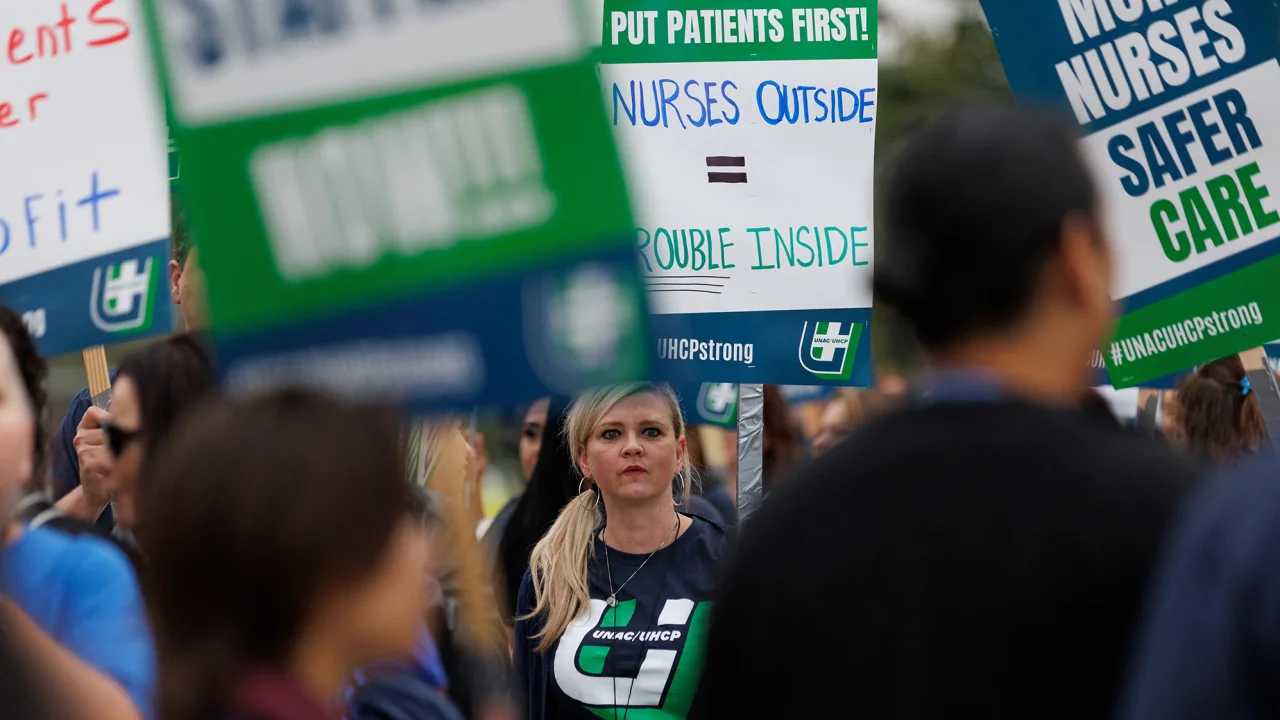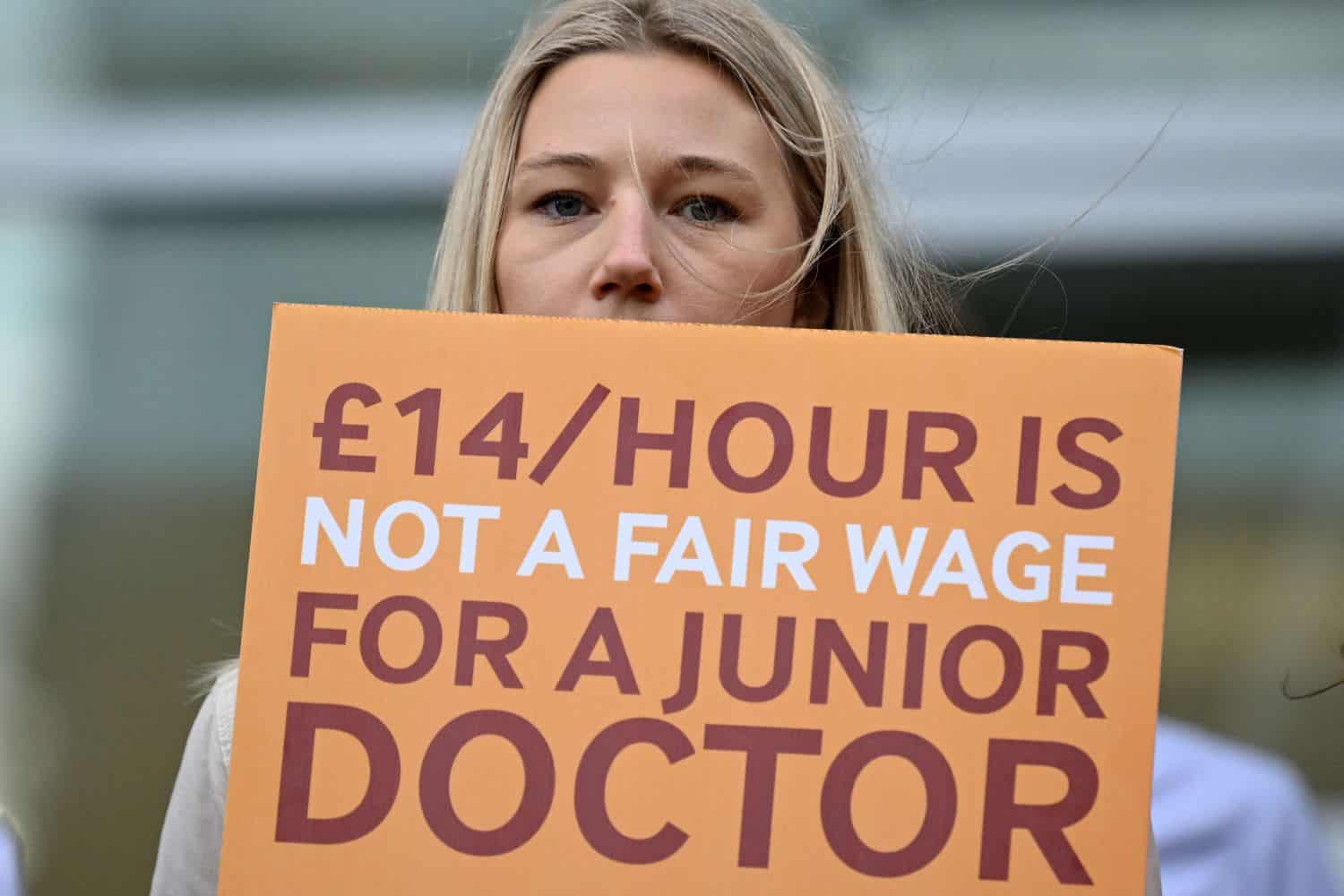
Registered nurses at Kaiser Permanente San Diego held a one-day informational picket outside one of the company's three medical centers in San Diego, California, U.S., September 19, 2023. /Reuters
Registered nurses at Kaiser Permanente San Diego held a one-day informational picket outside one of the company's three medical centers in San Diego, California, U.S., September 19, 2023. /Reuters
Over 75,000 healthcare workers at Kaiser Permanente in the U.S. are poised for a three-day strike. The strike, potentially the largest in the history of healthcare strikes in the country, looms as labor negotiations remain at an impasse.
These workers advocate for better pay and more staffing from the Coalition of Kaiser Permanente Unions, a major not-for-profit healthcare provider based in California. Kaiser serves 12.7 million members and operates 39 hospitals and 622 medical offices, according to its website.
Contract negotiations between the healthcare provider and union representatives continued and are set to resume on Tuesday to prevent a potential strike.
A statement released by Kaiser on Monday indicated that talks between the involved parties "have been making progress" and they have agreed to extend the meetings until midday on Tuesday if necessary.
While doctors and most nurses are not expected to participate in the strike, the healthcare system could face disruption if medical technicians and nursing assistants were to walk out, reported local media.
What fueled the strike?
Workers from the unions want Kaiser to improve staffing levels, which have deteriorated due to the COVID-19 pandemic, and to address their demands on wages and benefits. The strike also aims to protest unfair labor practices and address the staffing shortage issue, said a release from Kaiser.
According to a 2022 report over 33,000 health care workers in Service Employees International Union-United Healthcare Workers West (SEIU-UHW), 83 percent reported severe or moderate understaffing in their departments.
Additionally, 74 percent stated they regularly lacked sufficient time to provide proper patient care, while 46 percent admitted to frequently or occasionally having to skip breaks or meals.
"People are overworked, people are not able to give the patients what they deserve," said a customer service representative of Kaiser Permanente to China Media Group.

The newly constructed Kaiser Permanente San Diego Medical Center hospital in San Diego, California, U.S., April 17, 2017. /Reuters
The newly constructed Kaiser Permanente San Diego Medical Center hospital in San Diego, California, U.S., April 17, 2017. /Reuters
Kaiser and the coalition last engaged in contract negotiations in 2019, a year prior to healthcare workers being thrust onto the front lines of the COVID-19 pandemic, compelled to work under deteriorating conditions.
Despite receiving public praise during the pandemic, there exists a more distressing reality, including unprecedented patient surges, overwhelming workloads, risks to both healthcare workers and their families, as well as an unprecedented level of physical exhaustion, SEIU-UHW report said.
“Workers are really being squeezed right now,” said Renee Saldana, a spokesperson for SEIU-UHW, adding that they endured the worst global health crisis in a generation, and now are grappling with rent and housing insecurity.
Nurses are also facing growing pressures. A 2023 survey of registered nurses examines how COVID-19 has affected their career plans and job satisfaction. Among the more than 18,000 nurses surveyed, 30 percent expressed a likelihood of leaving their careers due to the pandemic. Only 15 percent plan to remain in their current positions in the coming year, with the remaining 85 percent considering alternative nursing employment opportunities.
Healthcare staff burnout in Europe
Similarly, healthcare professionals in Europe have been grappling with challenging conditions when it comes to their salaries and working environments, despite their efforts and long hours spent away from home during the pandemic.
In 2022, doctors in several European countries including France, Germany, Spain, Portugal, Greece, and Turkey, staged protests demanding for increased wages and solutions to the staffing shortages in their hospitals.
Strikes continue in 2023. In March, doctors at municipal hospitals across Germany went on strike calling for compensation for inflation since the last pay raise in autumn 2021 and a 2.5 percent pay increase for the 55,000 hospital doctors.
The latest one happened on Monday when thousands of health professional walked off the job to protest government health policies that failed to help them cover rising costs.

A National Health Service worker holds a placard at a picket line outside University College Hospital in central London, September 20, 2023. /AFP
A National Health Service worker holds a placard at a picket line outside University College Hospital in central London, September 20, 2023. /AFP
In the UK, junior doctors, who make up 45 percent of the total number of doctors in the National Health Service (NHS), initiated their fifth round of industrial action in August.
Thousands of these doctors participated in picket lines, shortly after they had just started their first positions within the NHS. This follows a series of strikes by nurses in December 2022 and earlier this year.
The British Medical Association (BMA) said that newly-qualified doctors are earning an hourly wage lower than that of a barista at the coffee shop chain Pret-a-manger, and they have seen their pay decrease by 26 percent in real terms since 2008.
In September, for the first time in the 75-year history of the NHS, both consultants and junior doctors went on strike simultaneously, protesting pay offers that fell below the inflation rate and grueling workloads.
Shane Delamont, a neurology consultant, said he never thought of going on strike, and the decision is "built up over a number of years."
He told the BMA that the ongoing pressures on NHS funding, which began with the austerity policies of the David Cameron-led government, had set the stage for the strike.
Doctors, he added, were becoming increasingly frustrated with the government's persistently inadequate support, despite their tremendous efforts during the pandemic.